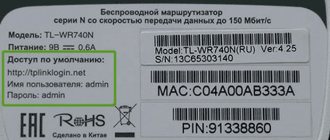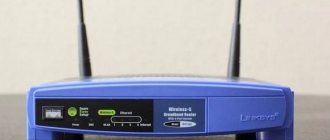Author of the article
Sergey Sakadynsky
He worked in the field of IT consulting, was engaged in the creation and administration of Internet resources. 10 years of experience in designing and maintaining computer networks.
Not only a computer can be connected to the Internet. Televisions are also not far behind in this regard. The Smart TV function on a Samsung TV expands the capabilities of the TV receiver. You can watch videos online, play games and browse websites. By connecting a wireless keyboard and mouse, you can turn your TV into a full-fledged PC.
In this article we will figure out how to connect the Internet to a Samsung TV. This procedure is not complicated, but sometimes users have difficulties. We will try to answer all important questions related to connection.
How to find out if my Samsung TV can connect to the Internet
Before connecting to the Internet, you should make sure that your TV receiver can do this. After all, today they still use old TVs that do not provide such an opportunity.
TVs with the Smart TV function (Smat Hub) can access the Internet. The easiest way to find out if your receiver has this feature is to look at the instructions or packaging. The inscription Smart TV is usually printed on the box in the most visible place.
If you've lost or thrown away the packaging and instructions, check the list of smart TV models on Samsung's website to see if yours is among them. There are two ways to find out your TV model.
The first is to look at the sticker on the back panel. The model will be listed at the top.
If the sticker is damaged, open your TV's menu. Go to “Support” – “Contact Samsung”. In the “Model Code” field you will see the TV model.
In order to find out whether your Samsung TV supports the Smart TV function, you just need to know its series. It is indicated in the model code. The first two letters of the code are the type of TV, the numbers after are the diagonal in inches, and the next letter is the series.
You can use the Internet on TVs of the E, F, H, J series (connection is only available via cable) and K, N, M, Q, LS, R, T (can be connected via cable and Wi-Fi).
How to check the connection
In case of signal instability or interruption of a previously established connection, it is necessary to determine the factors of failure. Information about the problem that has arisen can be seen in the “Network” section.
In the Status window, note the IP address and access channel.
There are two common hindering reasons for fighting:
- chain Internet - router;
- router path - TV.
In the first case, the lack of connection is due to a malfunction of the router. To resume data transfer, you need to take the following methods:
- reduce the distance between TV and router;
- do a reboot by disconnecting from the network;
- When connecting via an external adapter, remove the device from the USB port and insert it back after a few minutes.
In case of failures on the router-TV path, you need to reset and re-set up Smart-TV. To do this, you need to launch the “IP” field and select manual entry of parameters. In the window that opens, enter the properties of the router, which are indicated on the back panel of the router case .
In the proposed tab, click “Save” and run troubleshooting testing.
Resetting network settings is done as follows:
- select “Support” from the menu;
- open the “Self-diagnosis” tab;
- click on “Reset”.
The system will require you to enter a PIN code, which is equal to four zeros. Afterwards, the network parameters will be completely reset.
When performing a full reset to factory settings, you need to call a specialist from the provider.
Connection methods
There are three ways to connect the Internet to a Samsung TV.
- Cable connection is available on all Samsung Smart TV models. You can connect the TV with a patch cord to the router or connect directly to the provider using a cable brought into the apartment. The second option is not always possible. This depends on your type of internet connection.
- If you have a built-in Wi-Fi module, you can connect your Smart TV to your router’s wireless network.
- For TVs without a Wi-Fi module, an external adapter is used for wireless connection. To do this, you need to purchase and install a USB device from Samsung or a compatible one from another manufacturer. Connecting a Samsung TV via a Wi-Fi adapter is described in detail in a separate article.
Briefly about choosing a method
- If you only need access to the Internet via TV, then you can do without a router. The cable that comes into the apartment from the provider's distribution box is inserted into the LAN connector of the TV. In this case, it is necessary to think over the cable laying scheme and its masking. You can hide the wire in a cable duct, or run it through furniture.
- If, in addition to the TV, other equipment (phones, laptops) also need the network, then you will need to configure a router. Then there are two possible connection methods: Direct, when a cable runs from the router to the TV. This is a cable connection, the same as without a router. Only the Wi-Fi device will be an intermediate link, in turn distributing wireless Internet. This option is needed when, in addition to the TV, you need to use the network on other devices. The second method is to connect over the air without connecting with a cable. The advantage is that there is no need to lay a cable, but signal loss is possible.
It’s worth explaining a little more about the specifics of the provider’s work. It depends on the operating technology which connection to use when choosing a cable method - direct or through a router.
The Internet can operate using different technologies. Most often, you don't need to configure anything on the connected device. You simply connect the patch cord directly to the router or equipment, and the Internet is immediately active. This means that the network operates with a dynamic IP address, and the network parameters are determined automatically. The vast majority of providers work with dynamic IP. This greatly simplifies the connection. No setup needed at all.
Another option is a static IP. The difference from dynamic is that parameters are not automatically determined. You need to find out the network data yourself from your provider. This connection requires a little internet setup on each device. You must fill in the IP, mask, gateway, DNS. Afterwards, the equipment will connect using this data and the network will work.
In both cases described, connecting the cable directly to the TV will work.
Another situation is when the provider requires authorization on the client side. That is, when connecting, you are required to enter a login and password, which are assigned when concluding the contract. You cannot configure this type of Internet connection on TVs. Therefore, an intermediate link is required that will take over the settings. The router will play the role of intermediary. All settings are made on the computer. Next, a cable leads from the router to the network connector of the TV. It is difficult for the average user to make these settings. Typically, the configuration is handled by a master installer from the provider when connecting the apartment to the Internet.
Wired connection
Connecting via cable is possible in two ways: direct and through a router. In the first case, the provider's cable is connected to the LAN port of the TV.
But this method will not work if you have a PPPoE, L2TP or any other connection that requires you to specify a login, password or server address. TVs cannot work with such connections.
Therefore, it is better to use a router to access the Internet.
Set up the Internet on your router before connecting your TV. Also check whether the DHCP service is enabled on it to automatically distribute IP addresses to client devices.
Now we will show you step by step how to connect TVs of different series to the Internet via cable. The menu interface, names and location of items may differ, but the setup principle is similar.
Series LS, N, M, Q, R
Connect the cable to the network port. The Internet will not start working automatically. To connect your Samsung TV to the network, press the Home button on the remote control (the image of a house) and select “Settings” on the screen.
In the menu that opens, go to “General” and find “Network” there.
In the “Network” section, click “Open network settings”.
The TV will ask you to select the network type. In our case it is “Cable”.
Click on this item and wait for the TV to set up the connection. It can take some time. When the Internet connection is established, you will see the following message on the screen:
Click OK and use it.
Series K
Connect the network cable to the TV. Depending on the model, press the “Menu” button or the button with the image of a house on the remote control. Select “Settings” on the screen and go to the “Network” section.
Click “Open network settings” and select cable as the network type.
The TV will check the availability of the Internet connection and configure it. A message appears indicating that the setup is complete. Click OK and check if the internet is working.
Series J
To enter the settings on the remote control, press the MENU or Menu/123 button. On the screen, select “Menu” in the upper left corner.
Click “Network” (globe icon) and go to the “Network Settings” section.
The connection setup will start. Do not press any buttons, wait for the process to complete. The message “TV is connected to the Internet” will appear on the screen. Click the “Close” button on the screen.
Series F, H
Make sure the network cable is connected to the LAN port. On your remote, press the Menu, Keypad or More button. The remote controls are different for different models. Select “Menu” on the screen.
To set up the Internet, click “Network” (globe image) and enter the “Network Settings” section.
Select the network type from the drop-down list. In our case it is “Cable”.
Click the “Connect” button.
And wait for the message “The wired network connection and Internet connection have been set up” to appear. Click OK and enjoy all the features of smart television.
Series E
Connect the wire, press the Menu button on the remote control and open the “Network” section. Go to “Network Settings”.
The TV will detect the network connection and write that the cable is connected. To set up the Internet, click the “Start” button.
When a window appears indicating a successful connection, click OK.
FIRMWARE UPDATE FOR SAMSUNG SMART TV
UPDATING SAMSUNG SMART TV F SERIES (2013 release) VIA USB
F series TVs (2013) lack some menu items found on older models.
- Go to the Samsung website, open the support section and download the firmware for your TV.
- Format the flash drive to FAT32.
- Upload the downloaded file to it and extract it by clicking “Extract”. Wait for the installation to complete.
- Connect the flash drive with the firmware to the TV connector labeled USB HDD. If this is not the case, use another USB connector.
- Open “Support”, select “Software Update” - “Update Now”. Wait until the installation of the new firmware is completed.
Wi-Fi connection
If your Samsung Smart TV has a Wi-Fi module, you can set up an Internet connection through a router. The wireless network must be turned on and configured on the router.
We provide instructions for connecting via Wi-Fi using the example of different series of TVs.
Series LS, N, M, Q, R
To connect your TV to the Internet, follow the same steps as for a cable connection. On the remote control, press the Home button, enter settings, open the menu item “General” – “Network” – “Open network settings”. In this case, select “Wireless” as the connection type.
The TV should detect available wireless networks nearby and display a list of them. Find your router in it and click on it.
You will need to enter the password for your wireless network. We recommend checking the “Show password” box. This way you will see the characters you are typing and will be less likely to make a mistake.
If your password uses capital letters, be aware of this and remember to switch the case.
When the password is entered, check it is correct and click the “Done” button. Wait until the connection is established. Now click OK. The setup is complete.
Series K
Press Menu or Home on your remote, depending on your model. In the settings menu, select “Network” and click “Open network settings”. Select the network type “Wireless”.
A list of Wi-Fi networks will be displayed. Find yours, click on it and enter your password. Check that the input is correct, click “Done” and wait until the TV connects to the Internet via Wi-Fi.
Series E, F, H, J
Samsung TVs of these series are not equipped with a built-in Wi-Fi module. To connect to a wireless network, you will need to purchase an external USB adapter. Otherwise, setting up the Internet via Wi-Fi for these TVs can be just as easy as for models with a built-in module.
Connect the USB Wi-Fi adapter to the TV. Enter settings by pressing the button on the remote control. All actions are performed in exactly the same way as with a wired connection. Enter the network settings and select the “Wireless” type. Find your router in the list and click on it.
Enter the password and wait until the TV establishes a connection with the router.
Connection via LAN cable
As mentioned earlier, a wired connection is far from the most convenient option, since you need to insert an Ethernet cable into the LAN port, therefore, sometimes you have to pull the cord across the entire room. However, there are also advantages. Videos on a Samsung TV running online will definitely not slow down. It should also be noted that the signal is as clear and stable as possible.
Experts strongly recommend connecting Smart TV through a router. What is this connected with? The thing is that all providers have different Wi-Fi standards, sometimes they are not compatible with television equipment. Therefore, first connect the cable to the router, and only then to the TV.
If you are using a model older than 2012, then you will have to configure the IP manually. In fact, this is quite easy to do. Follow the simple step-by-step instructions:
- Take the remote control and turn on the TV.
- Open the main menu.
- Go to the “Network” subsection.
- Switch to the Network Settings tab.
- Select "Network Type" and then "Cable".
Newer models adjust to the connection type automatically. Therefore, there is no need to perform such manipulations. When you are done, click on the “OK” button. Now you can open websites, play content, and generally use the Internet.
Is it worth buying a modem for your TV? An external adapter is often purchased by owners of Smart TV models that are not equipped with a Wi-Fi adapter. However, if you plan to set up a direct connection, then you absolutely will not need any additional devices.
Connection speed control
In order to fully use Smart TV, you must have a stable Internet connection at a speed of at least 20-30 Mbit/sec. If the connection drops periodically and the speed drops, some features may not work and the video may appear jerky or freeze. A sign of a drop in speed may be a distorted image and a lag between the video and the sound.
Reasons for low speed may be:
- the speed in the provider's tariff is too low;
- line failure;
- the router cannot cope with the load;
- the communication channel is overloaded;
- There were communication problems between the router and the TV.
Let's break it down point by point.
- Look at the contract with your provider to see what speed you have stated. If there are several devices in the apartment that use the Internet, a speed of 20-30 megabits may not be enough. It is recommended to upgrade to a tariff plan with a speed of 100 Mbps.
- Check if the Internet works on other devices. Test your speed with an online test. If it is lower than stated by the provider, contact technical support.
- If you have an old router, it may not be able to handle the increased load. Perhaps, when only a laptop and a smartphone were connected to the Internet at home, its resources were quite sufficient. However, watching videos online, especially in high quality, creates an increased load on the router. If other devices are connected to the network, the router may freeze and turn off. Or you will have slow internet. Also, the router can reduce the speed. Even if you have an incoming channel of 100 Mbps or more, on a Wi-Fi network your devices may only receive 10-20 Mbps. In this situation, only replacing the router with a more powerful one will help.
- The problem is relevant for high-rise buildings where many wireless networks intersect. Your router may be interfered with by your neighbors' routers. Try manually setting up the channel on your router. If you still have problems with Wi-Fi speed, connect your TV using a cable. A wired connection is more stable and less susceptible to interference.
- As a result of a software glitch, errors may occur on your TV or router (or both devices at the same time). Because of them, the quality of the connection deteriorates. First, try turning off and on the TV and rebooting the router. If this doesn't help, remove the wireless connection on your TV and set it up again. If problems persist, update the software on both devices.
Connecting to a network using WPS
There is also a faster way using WPS technology (TP-Link routers call this function QSS). It is necessary that both the router and the TV support this function. To connect using this method:
- Open the menu item “Settings” -> “WPS”.
- Find the WPS button on the router, press it and hold it for some time. Typically this process is completed in a few seconds, but in some cases it may take up to 1 minute.
- The connection result will be displayed on your TV screen.
As you can see, when using this technology you do not need to enter any settings at all, everything is registered automatically. This is its big advantage.
Possible problems
The TV does not have wireless network settings
Your TV may not be able to connect to wireless networks. Make sure your model supports Smart TV. When everything is in order with this, check for built-in Wi-Fi module in the devices of your series. If the module is there, but there are no settings, try updating the firmware. It is also possible that the TV is broken. In this case, you need to contact the service center.
A TV without a Smart TV will not be able to connect to the Internet. In this case, you can purchase a set-top box.
The TV does not see or does not find the Wi-Fi network
Check if your router is working and if wireless broadcasting is turned on. Open the list of Wi-Fi networks on your smartphone and make sure it sees your network. If you have hidden the SSID (network name) in your router settings, disable this option.
Follow the link for a detailed article on how to set up a Wi-Fi router.
Turn off and turn on the TV again. Try connecting to the network again.
Perhaps the distance between the TV and the router is too great. Try placing your router nearby. If the problem disappears, find a permanent place for it near the TV or use a repeater to strengthen the signal.
If Wi-Fi still doesn't work, reset your TV to factory settings.
If the TV does not see wireless networks at all, contact a service center.
An error appears when connecting to Wi-Fi
Check that the password is entered correctly. It's easy to make a mistake when typing a code from the remote control. Make sure you remember to switch to a capital letter if required.
The problem may be in the router settings. Reboot it. Reset your wireless network. Try connecting your Samsung to the Internet again.
If all else fails, check if the TV is connected to a different network. Turn on your phone's wireless hotspot and connect to it. If the connection still cannot be established, there is most likely a breakdown.
Wi-Fi network is connected, but there is no Internet
When your Samsung TV has successfully connected to the wireless network, but the Internet is not working, make sure that the connection is available on other devices. If the Internet is connected to the router, check the TV settings.
Open the settings, go to the “Network” – “Network Status” – “IP Settings” menu. The “Receive automatically” option should be selected here.
Try changing the DNS server. Here, in the IP settings, check the “Manual” box and enter Google DNS 8.8.8.8 and 8.8.4.4.
If the problem persists, reset your TV or update its firmware.
The connection does not switch to wireless during setup
You are trying to set up a Wi-Fi connection, but the TV stubbornly demands a cable and does not switch to the wireless network. The reason is most likely the following. You or someone else has already set up a cable connection. There was an error in the process. The TV has remembered the wrong settings and is now crashing.
Connect the TV to the router with a cable and configure the wired connection. After this, configure Smart Hub according to the instructions. Disconnect the cable and set up a Wi-Fi connection.
Some Samsung models connect to the network via cable by default. If the cable is connected, you will not be able to go to Wi-Fi settings. Disconnect the wire from the network port and configure the wireless network.
How to access the Internet from a Samsung TV
Once you have set up the Internet on your Samsung TV, you can use search and open any sites. To do this, press the Smart button on the remote control or, depending on the model, the Menu button. Samsung TVs already have a built-in browser by default. It is usually located on the main screen of Smart Hub.
If it is not there, open the menu (three lines on the right) and find the browser in the list of applications. Use it the same way you would on a computer. You can set search queries, save bookmarks, or enter the address of any site manually.
You will also already have pre-installed applications for the Internet - YouTube, social networks, online cinemas. You can install other applications through the Samsung Apps store.
How to install applications on Samsung
After connecting to the Internet, the user can easily download any application, including official ones from the company. On a smart TV, you can use widgets to perform different functions; they make using the device more interesting and fun.
Note! The user can also download other applications because Samsung has allowed it.
The user can download games, online cinemas, and music players - everything that he may need in the future. To find out how to install applications on Samsung, just look at the activation instructions. In general terms it looks like this:
- Turn on the device and tap on the main menu. The button for it can be found on the remote control;
- Next, you need to tap on “Network”, which includes settings, make sure the TV is connected;
- We create an account if it has not been on the device before. To do this, you need to open the Smart Hub program;
- After that, enter your username and password, click the button to agree to the terms;
- All that remains is to enter the name of the widget and install it.
This simple process can be used to install any widget.











